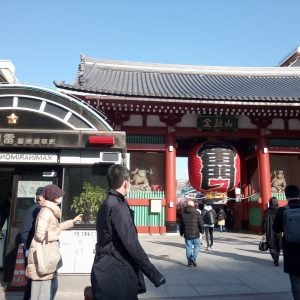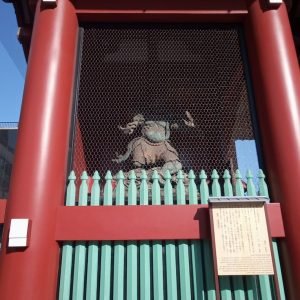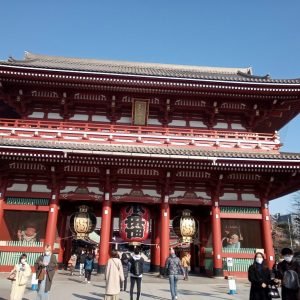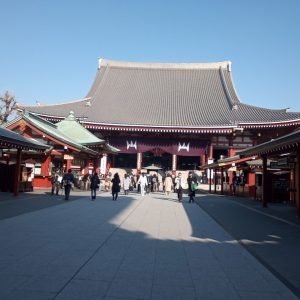from 4 reviews
45
Daily Tour
40 people
___

















Hi everyone, I am your tour guide, Haruka 🙂


In this virtual tour, I introduce the history and Japanese culture of Asakusa, located in downtown Tokyo. Asakusa has prospered as one of the downtown areas since the Edo period around the 17th century, and after the Great Kanto Earthquake of 1923, when it was burnt down mainly by fire rather than by shaking due to the solid ground of the Asakusa plateau, it was newly urbanized, including road expansion, according to the urban planning of the Tokyo prefectural government. Even today, Asakusa is a bustling tourist town with a downtown atmosphere.

The Kaminarimon (Thunder Gate) is located at the entrance to Sensoji Temple. Its official name is Fujin Raijinmon. The statues of the wind gods are on the right side facing the Kaminarimon, and the statues of the thunder gods are on the left. On the bottom of the lantern is a sculpture of a dragon. In Japan, it is believed that dragons live in the ocean and have the power to bring clouds and rain. Asakusa used to be a fire-prone town with dense wooden buildings. For this reason, dragons were revered as the gods of
dragons, who saved people from fires by bringing rain.

The large lantern at Kaminarimon has a deep connection with the Japanese electronics group Panasonic. Konosuke Matsushita, the founder of Matsushita Electric Industrial (now Panasonic), was suffering from an illness and went to visit Sensoji Temple to pray for healing. After he was cured, he donated the gate and the large lantern as a thank you, and the current Kaminarimon was established. Even today, the name of Konosuke Matsushita, the founder of Matsushita Electric Industrial, is engraved under the large lantern.

After passing through Kaminarimon, there is a street called Nakamise Dori that stretches 1500 meters to the main hall. This is one of the oldest shopping streets in Japan, with about 90 stores lining the street. You can buy traditional sweets, kimonos, and souvenirs that can only be found in Asakusa.

Continue along Nakamise Dori and you will come to Hozomon Gate. This gate is also called “Niomon” because it houses the statue of Niou. During the Edo period (1603-1868), Sensoji Temple gave special permission to the general public to climb up to the top of the gate for a certain period of time. People in those days enjoyed the view from the top of this gate very much. Considering the fact that there were no skyscrapers in those days, you can imagine how excited the people must have been.

The Niomon Gate is decorated with a large sandal, so-called Waraji in Japanese that is 4.5 meters high, 1.5 meters wide, and weighs 500 kilograms. It is said that the devil will be surprised and go away when he realizes that someone wearing such a big straw is guarding this temple. Next time you visit Senso-ji Temple, be sure to check out the size of the Waraji.


After passing through the Hozomon Gate, you will see Sensoji Temple in front of you. On both sides of it are what are called omikuji. In Japan, omikuji is mainly used at New Year’s to predict the year’s fortune. It is divided into seven main categories.
大吉:great blessing / great fortune 吉 :blessing / fortune 中吉:middle blessing / middle fortune 小吉:small blessing / small fortune 末吉:future blessing / future fortune (good fortune but you'll have to wait) 凶:curse / bad fortune 大凶:great curse / great bad fortune

The five-story pagoda houses the remains of Buddha, and its five roofs have the following meanings: earth, water, fire, wind, and sky. The five-story pagoda of Sensoji Temple was destroyed by fire in the Tokyo Air Raid but was rebuilt in 1973.

Sensoji Temple is also called Kannon-do because it houses the statue of Saint Kannon. The old hall was rebuilt in 1649 but was destroyed by fire in the Tokyo Air Raid in 1945. The current building was rebuilt in 1958 and is made of reinforced concrete. In the outer sanctuary, there are ceiling paintings of dragons and celestial maidens, and a statue of the Holy Kannon is enshrined in the center.

Younger generations tend to wear kimonos and visit the shrine, as shown in the photo.

In this virtual tour, we will visit Asakusa, Kaminarimon, Nakamise Street, Omikuzi, and Five-Storied Pagoda. I will share the history and culture of these attractions.
🖱 Message; Operation 1.398265 bitcoin. GET >>> https://graph.org/Payout-from-Blockchaincom-06-26?hs=5270add16f8e658275904a4199b03493& 🖱
am75jl